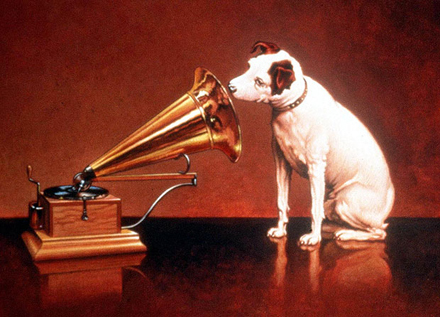When listening to recordings from the 1930s I am fairly certain I don’t hear the same thing as someone who listened in the ’30s. Even if the sound waves were identical — I could use a Victrola — the context is so changed, my reception of the sound so differently influenced that it’s different music now. Music is a transaction.
 When we categorize sound recordings as “music” we may make a misrepresentation. Isn’t this sound, these patterns of sounds, the cause, the inducement, left incomplete without listener response? So for all these decades, we have been recording only part of the story. And of course those sounds are completed into “music” as they are heard each time. This music continues to change. As each listener hears the recordings we have, different music is rendered every time.
When we categorize sound recordings as “music” we may make a misrepresentation. Isn’t this sound, these patterns of sounds, the cause, the inducement, left incomplete without listener response? So for all these decades, we have been recording only part of the story. And of course those sounds are completed into “music” as they are heard each time. This music continues to change. As each listener hears the recordings we have, different music is rendered every time.
In order to record, or preserve, a complete musical transaction we will need to record not only the sounds that are made but the responses they cause. An image of brain activity in the listener perhaps? We may not quite be ready to do it.
But we can have a better sense of old music as it becomes old, if we can record cause and effect. We might have better comprehended Lisztomania described by Heinrich Heine or the fervor induced by Elvis (or now Bieber). Let’s record not just sounds that are made but the complete circuit of music.

Bruce, I often think that music gets better as it gets older myself. I grew up in the 60s and 70s, where I think the best music came from, and didn’t think much of it back then. Now, compared to what we have now I can feel the music and appreciate it more. Same can be said about the 1920s and 30s Golden Era, some of which my Grandparents described with such great emotion.
I can’t agree with Bill Boggs any better. Music (and I’m talking mostly those great oldies) is like fine wine. It only ‘tastes’ better with the passage of time.
Interesting views here Bruce – just as always.
Will be looking forward to your latest post. Keep it coming mate!